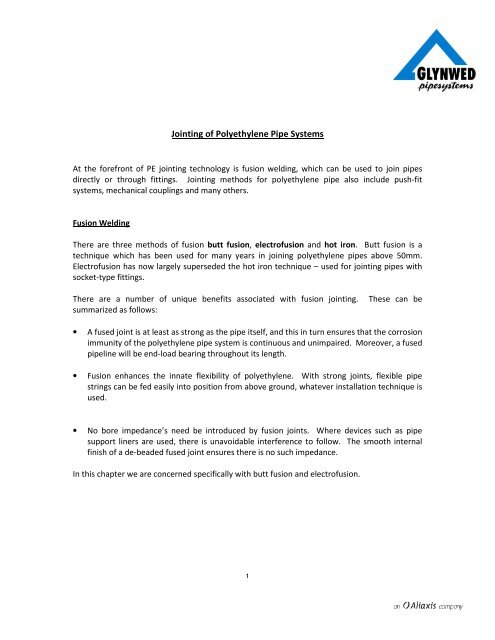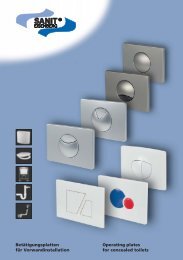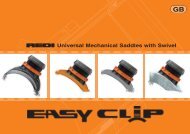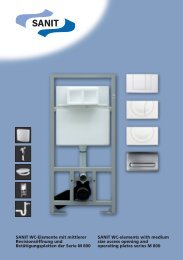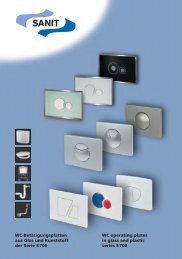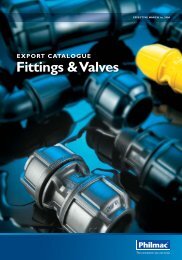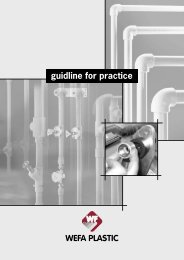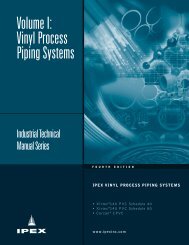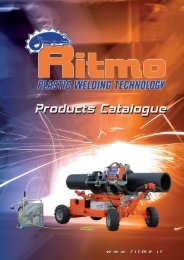Jointing of Polyethylene Pipe Systems - Glynwed Asia
Jointing of Polyethylene Pipe Systems - Glynwed Asia
Jointing of Polyethylene Pipe Systems - Glynwed Asia
Create successful ePaper yourself
Turn your PDF publications into a flip-book with our unique Google optimized e-Paper software.
<strong>Jointing</strong> <strong>of</strong> <strong>Polyethylene</strong> <strong>Pipe</strong> <strong>Systems</strong><br />
At the forefront <strong>of</strong> PE jointing technology is fusion welding, which can be used to join pipes<br />
directly or through fittings. <strong>Jointing</strong> methods for polyethylene pipe also include push-fit<br />
systems, mechanical couplings and many others.<br />
Fusion Welding<br />
There are three methods <strong>of</strong> fusion butt fusion, electr<strong>of</strong>usion and hot iron. Butt fusion is a<br />
technique which has been used for many years in joining polyethylene pipes above 50mm.<br />
Electr<strong>of</strong>usion has now largely superseded the hot iron technique – used for jointing pipes with<br />
socket-type fittings.<br />
There are a number <strong>of</strong> unique benefits associated with fusion jointing.<br />
summarized as follows:<br />
These can be<br />
• A fused joint is at least as strong as the pipe itself, and this in turn ensures that the corrosion<br />
immunity <strong>of</strong> the polyethylene pipe system is continuous and unimpaired. Moreover, a fused<br />
pipeline will be end-load bearing throughout its length.<br />
• Fusion enhances the innate flexibility <strong>of</strong> polyethylene. With strong joints, flexible pipe<br />
strings can be fed easily into position from above ground, whatever installation technique is<br />
used.<br />
• No bore impedance’s need be introduced by fusion joints. Where devices such as pipe<br />
support liners are used, there is unavoidable interference to follow. The smooth internal<br />
finish <strong>of</strong> a de-beaded fused joint ensures there is no such impedance.<br />
In this chapter we are concerned specifically with butt fusion and electr<strong>of</strong>usion.<br />
1
Butt Fusion<br />
In butt fusion the pipe ends to be joined are brought together in a dedicated butt fusion<br />
machine. The end faces are squared up by planing with a mechanical trimmer, then heated with<br />
thermostatically controlled non-stick heater plate. When molten, the faces are pushed together<br />
and allowed to cool.<br />
The butt fusion process generates weld beads both inside and outside the pipe. These can be<br />
removed easily to produce a smooth bore or outer surface. Inspection <strong>of</strong> the beads also<br />
provides a useful quality check on the weld.<br />
Codes <strong>of</strong> practice for mains-laying stipulate that this jointing method should be applied to pipes<br />
only, thus all fittings are delivered to site with half-metre ‘pups’ <strong>of</strong> pipe prefabricated to them.<br />
Detailed instructions on butt fusion technique is given under ‘A Guide to Good Welding’ below.<br />
Electr<strong>of</strong>usion<br />
This method uses socket-type fittings with integral heating elements to construct a pipe system.<br />
Couplers are used to join mains pipes; saddle fittings are used to connect service pipes. Fittings<br />
such a flange adaptors are spigotted and can be used in conjunction with electr<strong>of</strong>usion couplers<br />
and reducers.<br />
Within an electr<strong>of</strong>usion fitting there is a resistive heating wire connected to surface terminals.<br />
An electric current passed through the wire melts the polymer and fuses the fitting to the pipe<br />
wall.<br />
The pipe to be welded is first prepared by scraping away the outer surface layer, then pipe and<br />
fitting are clamped together to restrain movement. An electrical current is applied across the<br />
terminals from a generator via a control box (generally 40V in the UK). After welding the<br />
assembly is allowed to cool thoroughly before under clamping.<br />
Detailed instructions on electr<strong>of</strong>usion jointing technique is provided in ‘A Guide to Good<br />
Welding’ below.<br />
A Guide to Good Welding<br />
Though PE is relatively simple to weld, only by following the correct procedures can a sound butt<br />
fused or electr<strong>of</strong>usion weld be achieved every time.<br />
2
Safe handling <strong>of</strong> molten material<br />
During fusion welding <strong>of</strong> PE pipes and fittings, molten PE is formed. If allowed to come into<br />
contact with human skin, it will adhere strongly and burn severely. The thermal capacity <strong>of</strong><br />
molten PE is high and it will remain hot for some time.<br />
Gloves must be worn if there is any risk <strong>of</strong> skin contact. Small quantities <strong>of</strong> fumes may be given<br />
<strong>of</strong>f during welding – more pronounced at higher temperatures. Great care should also be taken<br />
where there is a risk <strong>of</strong> PE residues adhering to heated surfaces such as heating plates used for<br />
welding. Some ventilation is important in ensuring safe working conditions.<br />
Butt fusion welding<br />
Only approved, well maintained machines should be used. There are two basic types <strong>of</strong> welding<br />
machine, manual and automatic, the difference being that the welding cycle is computer<br />
controlled in the automatic machine. Modern equipment is hydraulically operated, the old<br />
pneumatic machines need a compressor as well as a generator and should not be used.<br />
Equipment<br />
• Generator to power the machine’s heater, trimmer and hydraulic pump.<br />
• Welding machine <strong>of</strong> suitable size, including clamp frame, clamp shells, trimmer, controller<br />
(for automatic machines) and hydraulic pump – an electrically operated pump is best, since<br />
it enables one person to carry out welds on pipe up to 250mm.<br />
• <strong>Pipe</strong> Support Rollers<br />
• <strong>Pipe</strong> end covers<br />
• Welding tent<br />
• Clean, dry, lint free cloth or paper towel.<br />
• External/internal debeading tool.<br />
• Bead gauge<br />
• Calibrated digital thermometer and probe.<br />
• Timer<br />
3
Pre-welding checks<br />
Before commencing a welding operation, check that:<br />
• The site is suitable for welding and a tent is used.<br />
• You know the correct welding parameters for the machine and pipe being welded. These<br />
are normally on the machine’s data plate. If in doubt, refer to our Technical Services<br />
Department.<br />
• The machine is complete and undamaged.<br />
• The generator has enough fuel for the work to be done.<br />
• The heater plate is clean – if not, was it while cold with lots <strong>of</strong> clean water and dry with a<br />
clean, lint free cloth or paper towel.<br />
• The trimming tool is clean and sharp.<br />
• The clamp shells are <strong>of</strong> correct size and clean, with no embedded grit which could lead to<br />
pipe misalignment.<br />
• The heater plate is at the correct temperature.<br />
• The pipes to be welded are <strong>of</strong> the same material and SDR (wall thickness).<br />
Dummy welds<br />
Before a welding session, a dummy weld should be carried out to clean the heater plate. The<br />
welding process (see instructions below for manual and automatic) should be followed up to the<br />
heat-soak stage, at which point the weld may be aborted. Any dirt will be transferred from the<br />
heater plate to the pipe end which, when cold can be retrimmed for welding.<br />
<strong>Pipe</strong>s larger than 180mm should be dummy welded twice before proceeding.<br />
4
Manual welding procedure<br />
<strong>Pipe</strong> end preparation:<br />
1. Place the welding machine on a clean, dry surface such as a board, enclosed within a tent.<br />
2. Open fully the machine carriage.<br />
3. Place pipes to be joined on rollers to ensure free movement during welding.<br />
4. Ensure pipes are correctly aligned and adjust rollers as necessary.<br />
5. Clean pipe ends, taking care to remove embedded grit.<br />
6. Fit pipe trimmer and place pipes on the welding clamp with pipe ends touching trimmer.<br />
7. Cover pipe ends to eliminate draughts.<br />
8. Tighten pipe clamps.<br />
9. Start trimmer and close machine carriage.<br />
10. Trim pipe ends until a running swarf strip <strong>of</strong> full pipe wall thickness is produced.<br />
11. While trimming continues, reduce carriage closing pressure to zero.<br />
12. Open the carriage fully.<br />
13. Stop machine and remove trimmer.<br />
14. Remove swarf. Do not touch planed surfaces.<br />
15. Check visually that both pipe ends are completely trimmed.<br />
16. Bring pipe ends together, check for alignment and gaps.<br />
17. If necessary adjust rollers, re-trim and check again.<br />
18. Determine drag pressure for the weld by noting pump pressure required to activate the<br />
machine.<br />
Note that when welding pipes larger than 315mm OD, always align the ‘TOP’ stamping mark<br />
on the pipes.<br />
Making the weld:<br />
1. Place heater plate in machine and close carriage.<br />
2. Apply the correct bead-up pressure (including drag pressure).<br />
3. When initial bead has reached required size around each pipe end, reduce gauge pressure<br />
to specified heat-soak pressure (or zero if none is needed).<br />
4. Heat-soak period begins as soon as bead-up pressure is released. Set trimmer to the right<br />
soak time for the pipe.<br />
5. Open carriage and carefully remove heater plate.<br />
6. Within maximum plate removal time, close carriage, bringing molten pipe ends together.<br />
7. Apply correct fusion pressure (including drag pressure).<br />
8. Check and maintain fusion pressure during in-machine cooling time.<br />
9. Carefully remove welded pipe string from clamps and allow to cool before stressing the joint<br />
excessively or de-beading.<br />
5
Post-welding checks:<br />
1. Use bead gauge to check that bead width meets specification.<br />
2. Check repeatability <strong>of</strong> weld beads along pipe string.<br />
3. Externally debead the weld and inspect for slit defects.<br />
4. Check for surface dirt on removed bead.<br />
Automatic welding procedure:<br />
Note that some manufacturers’ machines provide fully automatic pipe end cleaning, alignment<br />
and welding cycle, others <strong>of</strong>fer automatic welding cycle only.<br />
<strong>Pipe</strong> end preparation:<br />
1. Switch on controller and select pipe size and SDR rating.<br />
2. If preparation is not automated, proceed as for manual welding.<br />
3. Load trimmer into machine.<br />
4. Place pipes to be joined on rollers to reduce drag.<br />
5. Cover pipe ends to prevent draughts.<br />
6. Load and clamp pipe ends.<br />
7. Press “AUTO-TRIM” button on controller. Trimming will continue up to its programmed<br />
stop, but as soon as a running swarf strip <strong>of</strong> full pipe thickness is visible, trimming may be<br />
stopped by pressing the auto-trim button again.<br />
8. When trimming cycle is complete and carriage has opened, remove trimmer and swarf. Be<br />
careful not to touch pipe ends.<br />
9. Close carriage and check pipe alignment; re-trim if necessary.<br />
10. Visually check pipe ends for completeness <strong>of</strong> trimming.<br />
Making the weld:<br />
1. Load heater into welding machine and secure.<br />
2. Press ‘JOIN’ button on controller (this check heater temperature).<br />
3. Place heater in operating position, push home until fully locked.<br />
4. Press ‘JOIN’ again. Fusion cycle will be carried out automatically.<br />
5. When controller display show ‘JOINT COMPLETE’, press reset button.<br />
6. Remove heater plate, unclamp pipe and remove carefully.<br />
7. Allow pipe to cool properly before installation.<br />
6
The rules for butt fusion<br />
NEVER<br />
• Attempt to weld together pipes <strong>of</strong> different SDR (wall thickness).<br />
• Touch trimmed pipe ends.<br />
• Leave trimming swarf inside pipe or on welding machine.<br />
• Allow equipment to get wet or dusty.<br />
• Use non-approved machinery.<br />
• Remove a weld from the machine before cooling time has elapsed.<br />
• Allow untrained personnel to use welding equipment.<br />
• Cut corners in any part <strong>of</strong> the welding procedure.<br />
• Weld pipes <strong>of</strong> different material.<br />
ALWAYS<br />
• Support pipes on rollers.<br />
• Check pipe and welding clamps are clean.<br />
• Check for thoroughness <strong>of</strong> pipe trimming.<br />
• Check for alignment <strong>of</strong> pipe ends.<br />
• Measure the drag pressure for each weld.<br />
• Cover pipe ends to prevent draughts.<br />
• Use a welding tent.<br />
• Check that pipe wall thickness match before butt welding.<br />
• Stand well clear <strong>of</strong> automatic machines during operation.<br />
• Carry out a dummy weld at the start <strong>of</strong> a welding session.<br />
7
Electr<strong>of</strong>usion welding<br />
There are a number <strong>of</strong> electr<strong>of</strong>usion jointing techniques, some manual and some automatic,<br />
though procedures for preparation and assembly <strong>of</strong> welds is common to both. There are two<br />
types <strong>of</strong> fittings; socket welds and saddle welds. Most fittings need a 40V (2kW) supply, but<br />
couplers larger than 250mm need 80V (4kW).<br />
Equipment<br />
• 110V output generator <strong>of</strong> sufficient power to supply control box (generally 3-3.5kVA for 40V<br />
fittings and 6-7kVA for 80V)<br />
Electr<strong>of</strong>usion control box providing 2kW power at 39-40V RMS for 40V fittings or 4kW<br />
power at 78-80V RMS. The unit should be approved for this application where relevant<br />
specifications exist. Manual control boxes are suitable for nearly all electr<strong>of</strong>usion fitting<br />
types. Some automatic boxes require dedicated fittings and vice versa.<br />
• A combination generator and control box unit meeting the specifications stated above can<br />
also be used.<br />
• Clamping equipment, including pipe and restraining clamps for all couplings and tapping tee<br />
clamps to suit the type to be welded. If in doubt, consult our Technical Services<br />
Department.<br />
• <strong>Pipe</strong> scraping equipment capable <strong>of</strong> scraping pipe ends or tapping tee surfaces so that 0.05-<br />
0.2mm <strong>of</strong> pipe surface is removed, extending beyond the area to be covered by the fitting.<br />
• Ancillary equipment; welding tent, solvent based marker and clean, dry lint-free cloth or<br />
paper towel.<br />
8
Electr<strong>of</strong>usion socket fitting procedure<br />
<strong>Pipe</strong> end preparation:<br />
1. Check that pipe ends are less than 2% <strong>of</strong> pipe OD out <strong>of</strong> square to centre line.<br />
2. Wipe loose dirt from pipe ends with clean, dry, lint free cloth or paper towel.<br />
3. Scrape one pipe end completely for more that half the fitting length.<br />
4. Wipe <strong>of</strong>f loose swarf with clean, dry, lint free cloth or paper towel.<br />
Do not touch the scraped pipe surface or allow surface to get damp prior to continuing.<br />
5. Place prepared pipe end in restraining clamp.<br />
6. Open fitting bag, check the fitting is clean and place over pipe end.<br />
7. Mark penetration depth on pipe, leaving the bag over the fitting for temporary protection.<br />
Do not touch the bore <strong>of</strong> the fitting. All electr<strong>of</strong>usion fittings should be kept clean in their<br />
bags until welding. Loose dust can be removed with a clean, dry cloth or paper towel – if<br />
cleaning fails, reject the fittings.<br />
8. Prepare second pipe as described above.<br />
9. Remove bag and push second pipe home. Mark its penetration depth and tighten<br />
restraining clamps.<br />
10. Check fitting penetration – you should not be able to move it along the pipe.<br />
Making the weld:<br />
1. Check generator has enough fuel.<br />
2. Connect control box input to generator output and start generator.<br />
3. Connect control box output leads to the electr<strong>of</strong>usion fittings.<br />
4. Switch on control box.<br />
5. Check weld time marked on fitting; enter this figure into control box.<br />
6. Press ‘START’ and hold down until display begins countdown. When weld is complete,<br />
display will show a letter C.<br />
7. Allow weld to cool for time stated on fitting before removing clamps and moving assembly.<br />
Do not touch fusion indicators during steps 6 and 7.<br />
Quality checks:<br />
1. Check that fusion indicators have risen.<br />
2. Check that no melted material or wire has exuded from the fitting.<br />
3. Check that pipes have not pulled out during welding.<br />
If the weld fails any <strong>of</strong> these checks, cut it out and use another fitting.<br />
9
<strong>Pipe</strong>line repairs with electr<strong>of</strong>usion couplers<br />
In repair work electr<strong>of</strong>usion couplers are used without centre stops. The section <strong>of</strong> damaged<br />
pipe should be cut from the main, as squarely as possible, and the pipe ends cleaned and dried.<br />
The replacement section should be cut no more than 5mm shorter than the gap it is to fill, then<br />
each end should be cleaned thoroughly to beyond the depth <strong>of</strong> penetration.<br />
Welding is carried out as described above under ‘Electr<strong>of</strong>usion Socket Fitting Procedure’ except<br />
that, when setting up, the full depth <strong>of</strong> penetration <strong>of</strong> the repair coupler should be marked on<br />
one <strong>of</strong> each pair <strong>of</strong> pipe ends to be welded. This ensures that the coupler is positioned centrally<br />
over the pipe ends.<br />
Electr<strong>of</strong>usion saddle fitting procedure<br />
<strong>Pipe</strong> end preparation:<br />
1. Expose pipe on to which saddle is to be welded.<br />
2. Check for excessive ovality and that vertical or horizontal curvature does not exceed a radius<br />
<strong>of</strong> 25 times the pipe diameter.<br />
3. Remove loose dirt with a clean, dry lint free cloth.<br />
4. Still in its protective bag, place fitting over required position on the pipe.<br />
5. Mark pipe surface 10mm clear all round contact area.<br />
6. Scrape uniformly entire surface within marked area, removing between 0.05 and 0.2mm <strong>of</strong><br />
material.<br />
7. Wipe away any loose swarf with a clean, dry cloth or paper towel.<br />
8. Remove fitting from bag and attach to pipe with suitable clamping equipment.<br />
9. Do not touch the electr<strong>of</strong>usion surface <strong>of</strong> the saddle.<br />
Making the weld:<br />
1. Follow steps 1 – 7 ‘Making the Weld’, set out under socket fittings procedure.<br />
2. Allow an additional 15 minutes cooling time before tapping pressurized main with integral<br />
cutter or other approved device.<br />
Do not touch the fusion indicators.<br />
Quality checks:<br />
1. Check that fusion indicator has risen.<br />
2. Check that no melted material or wire has exuded from the fitting.<br />
If the weld fails either <strong>of</strong> these checks, do not tap the main. Carry out a repeat weld with a new<br />
fitting at least 200mm from the failed joint.<br />
10
Automatic recognition electr<strong>of</strong>usion fittings<br />
In automatic recognition systems, control box s<strong>of</strong>tware identifies the fittings being fused and its<br />
welding parameters. A number <strong>of</strong> electr<strong>of</strong>usion systems use bespoke fittings and control boxes.<br />
Pre-weld assembly procedure is as described above. Additionally with these fitting types you<br />
should always ensure that fittings and control box are compatible – if in doubt consult our<br />
Technical Department – and always check that the weld time shown on the control box matches<br />
that on the fitting.<br />
The rules for electr<strong>of</strong>usion<br />
NEVER<br />
• Touch prepared pipe surfaces, fitting bore or saddle.<br />
• Allow assemblies to get damp.<br />
• Leave fittings lying around out <strong>of</strong> their protective bags.<br />
• Leave assemblies for any length <strong>of</strong> time before welding.<br />
• Touch fusion indicators during welding.<br />
• Use dirty fittings – reject them.<br />
ALWAYS<br />
• Use approved equipment only.<br />
• Cut pipe ends square.<br />
• Scrape pipe surfaces thoroughly.<br />
• Use alignment clamps or stack loading clamps for tapping tees.<br />
• Allow the weld to cool properly.<br />
• Use a shelter in wet or in dry, dusty weather.<br />
<strong>Jointing</strong> PE to PE by Fusion<br />
PE pipes <strong>of</strong> different SDR<br />
NEVER BUTT WELD pipes <strong>of</strong> differing SDR for any pressure application, including gravity<br />
pipelines.<br />
Electr<strong>of</strong>usion fittings are designed to weld differing wall thickness’ (SDRs) using the same<br />
welding conditions, thus pipe and fittings <strong>of</strong> differing wall thickness’ can be joined successfully.<br />
Electr<strong>of</strong>usion fittings are available in a choice <strong>of</strong> 10 bar or 16 bar rating; be careful to ensure<br />
that the pressure rating <strong>of</strong> the fittings is equal to or greater than that <strong>of</strong> the pipe.<br />
11
<strong>Jointing</strong> different types <strong>of</strong> PE<br />
MDPE can be joined to MDPE either by butt welding or electr<strong>of</strong>usion. Different pipe producers<br />
may have alternative suppliers <strong>of</strong> preferred MDPE grades; these are all intended to be joined by<br />
identical techniques. Similarly it is intended that different grades <strong>of</strong> Excel can be joined<br />
together. Butt welding different pipe materials – for example, MDPE to Excel – is not<br />
recommended on site. Ask our Technical Services Department for advice in such instances.<br />
Electr<strong>of</strong>usion fittings are designed to overcome this problem and will join different grades <strong>of</strong><br />
polyethylene using the same welding conditions; thus pipe and fittings <strong>of</strong> different polyethylene<br />
grades can be joined successfully. Electr<strong>of</strong>usion fittings are available in a choice <strong>of</strong> 10 bar or 16<br />
bar rating. Be careful to ensure that the pressure rating <strong>of</strong> the fitting is equal to or greater than<br />
that <strong>of</strong> the pipe.<br />
<strong>Jointing</strong> blue to black PE<br />
The first step when intending to join blue to black pipe is to check it is allowed under local bylaws<br />
and codes <strong>of</strong> practice (ascertain, for example, whether black pipe is permitted for<br />
underground use and for potable water applications).<br />
Before attempting to join pipe and/or fittings <strong>of</strong> different colour, discuss the feasibility <strong>of</strong> your<br />
proposed system with the pipe manufacturers’ technical department.<br />
Assessment <strong>of</strong> Butt Fusion Welding Capability<br />
Visual Inspection<br />
All welds should be examined visually to check that the bead is the correct shape and size and<br />
that excessive misalignment <strong>of</strong> pipes has not occurred. It should be remembered however that<br />
it is possible to produce welds which appear perfectly satisfactory, but which will fracture easily<br />
in a brittle fashion.<br />
If the external bead formed by the welding process is removed when cold, by means <strong>of</strong> suitable<br />
equipment which does not damage the pipe it can be used to give an indication <strong>of</strong> the quality <strong>of</strong><br />
the weld. On examination following repeated bending <strong>of</strong> the weld bead, there should be no sign<br />
<strong>of</strong> any circumferential slit defect between the two halves <strong>of</strong> the weld bead and it should not be<br />
possible to separate the two halves. If any defect is observed, the weld should be cut out and<br />
retained for further investigation.<br />
12
Tensile Testing<br />
Dumbell-shaped tensile test specimens are cut along the length <strong>of</strong> the pipe, across the weld, so<br />
that the welded region is in the middle <strong>of</strong> the specimen. In the UK the “gauge length” is<br />
foreshortened from that <strong>of</strong> the specimen design used for tensile testing <strong>of</strong> pipes, in order to<br />
“force” failure at the weld rather than in the pipe itself. The specimens can then be “pulled” to<br />
failure in a suitable tensile testing machine. For a weld to be considered satisfactory, tensile<br />
specimens should show a large percentage elongation to failure (high degree <strong>of</strong> ductility).<br />
Microstructure Examination<br />
Thin sections cut across the butt fusion weld, can be assessed by examination <strong>of</strong> their<br />
microstructure under an optical microscope and using polarised light.<br />
In 1967 Menges and Zohren identified four zones in butt fusion welds but at the time <strong>of</strong>fered no<br />
comment on the nature <strong>of</strong> the zones, other than to suggest that they were the result <strong>of</strong><br />
temperature effects. Later, Barber at Leeds University etched his welds in chromic acid and<br />
using a scanning microscope, identified five zones. Further work by DeCourcy at Leeds showed<br />
that the zones represent areas <strong>of</strong> molecular orientation the welds. Molecular orientation is<br />
caused by the shear forces resulting from the flow <strong>of</strong> material during welding and it was<br />
observed that in the region <strong>of</strong> zone three the presence <strong>of</strong> internal stresses which result from the<br />
materials desire to return to its normal un-orientated state and these stresses will have a<br />
significant effect on the observed ductility <strong>of</strong> the weld.<br />
For the purposes <strong>of</strong> simple analysis, the width <strong>of</strong> the heat affected zone, will give a good<br />
indication as to the integrity <strong>of</strong> the butt weld. If the heat affected zone is thin, this implies that<br />
there has been excessive melt movement and that the bulk <strong>of</strong> the molten material has been<br />
“pushed” out from the joint interface which results in a high degree <strong>of</strong> molecular orientation at<br />
the interface, resulting in poor ductility <strong>of</strong> the weld. The most likely cause for this is excessive<br />
pressure at the pipe ends during fusion. Conversely a wide heat affected zone would indicate<br />
lower than the desired pipe interface pressure during fusion and in the worst case could give<br />
rise to void formation as cooling takes place.<br />
13
Non Destructive Testing<br />
The use <strong>of</strong> radiography may possibly detect large defects such as porosity, shrinkage cavities,<br />
cracks and inclusions but will not detect defects such as result from cold fusion and incorrect<br />
fusion pressures.<br />
Ultrasonic testing is known to be more sensitive in detecting the latter forms <strong>of</strong> defects but up<br />
until fairly recently, results with this technique have not been encouraging. However<br />
development work is ongoing and equipment is available which suggests much better success<br />
rates may be achieved.<br />
PE 100<br />
PE 100 a higher performance high density polyethylene. The unique chemical structure results<br />
in a product with superior physical properties. Impact toughness, tensile strength, and<br />
particularly resistance to rapid crack propagation being much improved on those <strong>of</strong> other PE<br />
pipe polymers.<br />
Sine its successful introduction to the water industry in 1990, PE 100 has seen considerable<br />
growth in its use, particularly in larger diameters. This has focused attention on the welding<br />
characteristics <strong>of</strong> thick walled, larger diameter PE pipes.<br />
Some properties <strong>of</strong> this new pipe polymer are quite different from both MDPE and conventional<br />
HDPE. Standard welding conditions developed for MDPE do not give optimum joints for thick<br />
walled pope. Reduced ductility is sometimes observed during tensile testing <strong>of</strong> welds made<br />
from pipe having walls <strong>of</strong> 25mm thickness or grater. This promoted a thorough investigation<br />
into the appropriateness <strong>of</strong> standard welding parameters for thick walled HPPE pipes and<br />
recommendations for revision have now been evolved.<br />
14
Butt Welding<br />
Butt welding is a simple thermal technique used to join a variety <strong>of</strong> materials and has been<br />
successfully adapted to join PE pipes. This tried and tested process involves imparting heat to<br />
prepare pipe ends so that melting takes place, enabling the pipe ends to be pushed together to<br />
form a welded joint. The applied pressure during fusion forces a portion <strong>of</strong> the molten material<br />
to be squeezed out giving a weld bead on the inside and outside <strong>of</strong> the pipe – indeed the weld<br />
bead itself may be used as a crude indicator <strong>of</strong> weld quality. The actual microstructure and<br />
performance <strong>of</strong> the joint will depend upon the welding parameters employed. The choice <strong>of</strong><br />
these is also influenced by environmental factors, pipe geometry and the characteristics <strong>of</strong> the<br />
pipe material.<br />
Recent finds have identified the potential for optimization <strong>of</strong> the weld parameters for jointing <strong>of</strong><br />
thick walled HPPE pipe. A dual pressure butt welding, technique which introduces a second, low<br />
pressure fusion stage to the butt weld sequence has been the subject <strong>of</strong> most extensive<br />
investigations.<br />
Testing <strong>of</strong> Welds<br />
Assessment <strong>of</strong> the weld quality under current specifications is a purely subjective judgment <strong>of</strong><br />
the appearance <strong>of</strong> test specimens following rupture. As a crude indicator or ductility developed<br />
in the weld this method is <strong>of</strong> some value – but is <strong>of</strong> limited use as a tool for optimization <strong>of</strong> weld<br />
parameters. In addition, the changing cross-sectional geometry <strong>of</strong> tensile specimens taken from<br />
pipes <strong>of</strong> differing wall thickness has a significant influence upon failure mode (this is currently<br />
being addressed). Of the various alternative test methods proposed the most valuable would<br />
appear to be the Charpy impact test. This method gives a route for developing numerical data<br />
directly related to material properties developed within the weld zone, and is not affected by<br />
tensile test piece geometry. Furthermore, fracture toughness related data is arguably <strong>of</strong> greater<br />
value in assessing the probable long term performance <strong>of</strong> real pipes.<br />
Tensile Testing<br />
Tensile testing using the foreshortened gauge length test piece specifically designed for the<br />
testing <strong>of</strong> butt welds, is a requirement <strong>of</strong> Water Industry standard 4-32-03.<br />
Tensile tests have been carried out on a range <strong>of</strong> welds using a variety <strong>of</strong> Excel pipe diameters<br />
and wall thickness’. Visible inspection <strong>of</strong> failure modes together with absorbed energy data,<br />
measured via extensometry during the tensile test, were used to assess and compare both<br />
standard and dual pressure welds <strong>of</strong> increasingly thick walled pipes.<br />
Findings showed that in all cases, the ductility <strong>of</strong> any particular weld was improved by using dual<br />
pressure weld conditions. Indeed with very thick wall pipe sections, where conventional weld<br />
parameters may result in an apparently brittle failure mode (at full wall thickness), dual pressure<br />
welding gives a satisfactory ductile weld appearance.<br />
15
Impact Testing<br />
Further testing <strong>of</strong> the HPPE material characteristics and the effect <strong>of</strong> varying weld parameters<br />
was carried out using the Charpy impact test. This test involves machining a standard series <strong>of</strong><br />
notched specimens cut from the weld (the notch being placed at the joint interface) and<br />
subjecting the specimens to specified impact loading.<br />
From dimensional aspects <strong>of</strong> the test pieces and measured impact data, a strain energy release<br />
rate (Go value) may be calculated. This value can be used as a measure <strong>of</strong> the impact toughness<br />
<strong>of</strong> any particular weld at its interface, and for evaluating the effects <strong>of</strong> varying weld parameters<br />
with greater sensitivity.<br />
Calculation <strong>of</strong> Strain Energy Release Rate (Gc)<br />
Gc – U x 1 x dC = U<br />
BxD C d(a/D) B>D>phi<br />
U = Absorbed Energy<br />
D – Depth<br />
B – Width<br />
a = Notch depth<br />
C – Sample compliance<br />
Test data show that plate temperature and particularly jointing pressure are the weld<br />
parameters which have the most pr<strong>of</strong>ound influence upon the impact toughness and ductility <strong>of</strong><br />
any weld. Slightly higher hot plate temperatures and reduced jointing pressures give superior<br />
weld performance. The dual pressure technique combined with a hot plate temperature <strong>of</strong><br />
230°C gives a good balance between superior weld performance and maintenance <strong>of</strong> polymer<br />
thermal stability.<br />
16
Interpretation <strong>of</strong> Findings<br />
In order to understand why dual pressure welding should improve weld properties,<br />
consideration was given to the relationship between weld parameters, structural response and<br />
subsequent joint property.<br />
Numerous investigations have been undertaken to optimize butt weld parameters notably the<br />
works <strong>of</strong> Potente and Menges. The results show that high integrity joints between MDPE pipes<br />
can be produced for a relatively wide range <strong>of</strong> welding conditions.<br />
Low pressure / low temperature conditions produce insufficient bonding or void formation due<br />
to non compensation <strong>of</strong> cooling contractions. Conversely, high pressure and excessive melt flow<br />
produces pronounced molecular orientation, and since it is this shear zone area which <strong>of</strong>ten<br />
contains the fracture in joint failures, this is undesirable.<br />
The understanding <strong>of</strong> such melt behaviour and structural re-organisation within a weld region is<br />
well established since Atkinson et al postulated the micro-structural ‘5-zone’ theory. ‘The<br />
theory states that a weld may contain up to five separate areas <strong>of</strong> structural variation depending<br />
upon weld conditions.<br />
HPPE behaves similarly to MDPE during welding but because <strong>of</strong> its molecular conformation and<br />
larger spherulitic microstructure, it is more sensitive to shearing effects.<br />
Dual pressure butt welding consists <strong>of</strong> a short duration standard pressure jointing stage (to<br />
allow full bonding at the interface), immediately followed by a secondary lower pressure<br />
jointing stage which minimizes shearing <strong>of</strong> the melt during cooling. This produces broader welds<br />
with maximum separation <strong>of</strong> opposing shear zones. Additionally the higher hot plate<br />
temperature <strong>of</strong> 230°C adopted for dual pressure welding aids molecular mixing and resulting in<br />
properties close to the parent pipe material.<br />
17


